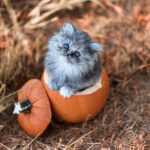Cats, just like humans, can experience anxiety. As devoted cat owners, we understand the importance of ensuring our feline companions are happy and stress-free. Managing cat anxiety is crucial for a harmonious relationship, and thankfully, there are many avenues to explore. Among these, Calming Cat Treats are emerging as a popular and palatable option to help soothe anxious kitties.
Understanding Cat Anxiety: What’s Making Your Kitty Uneasy?
Cat anxiety isn’t just a case of the jitters; it’s a sustained state of stress that can be triggered by various factors. Marilyn Krieger, a certified cat behavior consultant at The Cat Coach, points out that cats are creatures of habit. “A change in routine can be very jarring for a cat,” she explains. Anything from new environments and unfamiliar faces to household changes like renovations or even loud noises can trigger stress in sensitive felines.
Mikel Delgado, a certified cat behavior consultant and cofounder of Feline Minds, emphasizes the difference between fear and anxiety. “There’s a difference between cats that get scared during fireworks and cats that spend a lot of their time stressed out,” she notes. True anxiety is a persistent condition, not just a fleeting reaction.
Recognizing anxiety in cats is key. It can manifest in various ways, including:
- Hiding and Withdrawal: Your cat may become unusually withdrawn, seeking refuge and avoiding interaction.
- Loss of Appetite: Stress can lead to a decrease in appetite or even refusal to eat.
- Inappropriate Elimination: Anxiety can sometimes cause cats to urinate or defecate outside their litter box.
- Changes in Behavior: Increased vocalization, restlessness, or aggression can also be signs of anxiety.
On the flip side, a relaxed cat will exhibit comfortable behaviors: eating, drinking, and sleeping openly, interacting with their humans, playing, and generally being present and engaged in their environment.
The Appeal of Calming Cat Treats: A Tasty Way to Tranquility
When it comes to managing mild to moderate cat anxiety, calming cat treats offer a convenient and often well-received solution. These treats are specifically formulated with ingredients designed to promote relaxation and reduce stress in cats. While not a miracle cure for severe anxiety, they can be a valuable tool in your arsenal of calming strategies.
How Do Calming Cat Treats Work?
Calming cat treats typically contain natural ingredients known for their calming properties. Some common components include:
- L-Theanine: An amino acid found in green tea, L-Theanine is known to promote relaxation without drowsiness. It can help reduce stress and anxiety levels in cats.
- Chamomile: This herb has long been used for its calming and soothing effects. Chamomile can help relax muscles and reduce anxiety.
- Tryptophan: As mentioned earlier, this amino acid, famously found in turkey, is a precursor to serotonin and melatonin, both of which play roles in mood regulation and sleep.
- Alpha-Casozepine: A milk protein derivative, Alpha-Casozepine has shown promise in reducing stress-related behaviors in cats and dogs.
Delgado notes that ingredients like alpha-casozepine have been studied in specific situations, such as vet visits, and have demonstrated “at least a mild calming effect.”
Benefits of Calming Cat Treats:
- Palatability: Cats generally love treats, making this a stress-free way to administer calming support.
- Convenience: Easy to give and incorporate into your cat’s daily routine.
- Non-Prescription: Many calming cat treats are available over-the-counter, making them readily accessible.
- Natural Ingredients: Often formulated with natural calming agents, appealing to owners seeking gentler solutions.
Beyond Treats: Exploring Other Calming Products for Cats
While calming treats are a great starting point, it’s important to be aware of other options and how they can complement or serve as alternatives. As both Delgado and Krieger emphasize, every cat is unique, and what works for one may not work for another. Experimentation and observation are key.
1. Thundershirts for Cats:
These compression vests apply gentle pressure, similar to swaddling a baby, which can have a calming effect on some anxious animals. While research specifically on cats is limited, anecdotal evidence suggests Thundershirts can help reduce fidgetiness in cats. However, consider your cat’s tolerance to handling before trying a Thundershirt, as the process of putting it on could be stressful for some.
2. Cat Calming Collars:
Infused with pheromones that mimic those produced by mother cats, calming collars like the Sentry HC cat calming collar can help soothe some cats. However, effectiveness varies, and some cats may resist wearing collars. Gradual introduction and positive reinforcement with treats are recommended.
3. Cat Calming Pheromone Diffusers:
For cats who dislike wearing anything, pheromone diffusers like the Feliway® plug-in diffuser release synthetic feline facial pheromones into the air. These can create a calming environment, particularly helpful in multi-cat households with diffusers like the Feliway MultiCat diffuser plug-in. Diffusers offer a less intrusive approach compared to collars or vests.
4. Calming Cat Food:
Similar to treats, calming cat food formulas like Royal Canin® Veterinary Diet Calm formula dry cat food incorporate anxiety-reducing ingredients into their daily diet. These diets often address digestive sensitivities and urinary tract health, which can be linked to anxiety.
Choosing and Using Calming Cat Treats Effectively
When selecting calming cat treats, consider these factors:
- Ingredients: Look for treats with scientifically-backed calming ingredients like L-Theanine, Alpha-Casozepine, Chamomile, and Tryptophan.
- Quality and Brand Reputation: Choose reputable brands known for producing high-quality pet products.
- Cat’s Preferences: Consider flavors and textures your cat enjoys to ensure they will readily accept the treats.
- Specific Needs: If your cat has allergies or sensitivities, carefully review the ingredient list.
Tips for Effective Use:
- Follow Dosage Instructions: Adhere to the recommended serving size on the product packaging.
- Timing is Key: Give treats proactively before stressful events, such as vet visits, travel, or thunderstorms.
- Consistency: For ongoing anxiety, incorporate treats into a daily routine for consistent support.
- Combine with Other Strategies: Calming treats are often most effective when used in conjunction with environmental enrichment, playtime, and positive reinforcement training.
- Observe Your Cat’s Response: Monitor your cat’s behavior to assess the effectiveness of the treats and adjust as needed.
When to Seek Veterinary Guidance
While over-the-counter calming products can be beneficial for mild anxiety, it’s crucial to recognize when professional veterinary help is necessary. Delgado advises consulting a vet if you observe:
- Self-Harm: Over-grooming to the point of skin irritation, chewing nails excessively, or any self-injurious behavior.
- Severe Behavioral Changes: Aggression, persistent hiding, complete loss of appetite, or accidents outside the litter box that are not easily resolved.
Veterinarians can diagnose the underlying cause of severe anxiety and may prescribe cat anxiety medication when needed. They can also provide guidance on comprehensive anxiety management strategies. You can also utilize resources like Chewy’s Connect with a Vet for initial advice and direction.
Conclusion: Treats and Tranquility – A Path to a Calmer Cat
Calming cat treats offer a palatable and accessible way to help manage feline anxiety. By understanding the causes of cat stress and utilizing calming treats alongside other supportive measures, you can create a more peaceful and enjoyable life for your beloved cat. Remember to observe your cat’s individual needs and seek veterinary advice when necessary to ensure the best possible outcome for your furry friend’s well-being.
WRITTEN BY: 솔캣 넷 (solcat.net Content Creator)
Note: While the original author was Dr. Katie Grzyb, DVM, as a content creator for solcat.net, the byline is updated to reflect this.


